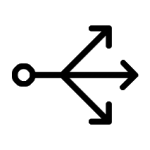The type of procurement that is likely to suit your specific case the best is: {quiz_grade}
Matching percentage: {quiz_percent}
The most relevant type of procurement procedures for deploying a mobility hub are:
Direct assignment without open tender
 The Direct assignment is the fastest and most basic method of procurement. It can be generally argued that this is not a form of procurement since there is no public procedure of selection, but for the sake of being as complete as possible, the method is taken into account in this tool. The direct assignment is a closed process in which the procuring party selects a service provider and gives them a one on one assignment if they are willing and able.
The Direct assignment is the fastest and most basic method of procurement. It can be generally argued that this is not a form of procurement since there is no public procedure of selection, but for the sake of being as complete as possible, the method is taken into account in this tool. The direct assignment is a closed process in which the procuring party selects a service provider and gives them a one on one assignment if they are willing and able.
The direct assignment is strongly connected to the questions asked in the preselection, due to the financial demands on procurement type selection. Most organizations have rules of their own regarding direct assignments without an open tender. The overarching rule to be taken into account is that as soon as an assignment passes over the threshold of € 215.000, you will need to procure on a European scale.
Open procedure
 If your research has shown there are few bidders who could meet your needs, you may decide to use the Open Procedure. This is where you send all bidders (who responded to the advertised opportunity) the full Invitation to Tender documents. This means there is no separate selection stage. The Open Procedure can be used freely in any circumstances and for any type of contract and Framework Agreement. Any interested bidder may submit a tender.
If your research has shown there are few bidders who could meet your needs, you may decide to use the Open Procedure. This is where you send all bidders (who responded to the advertised opportunity) the full Invitation to Tender documents. This means there is no separate selection stage. The Open Procedure can be used freely in any circumstances and for any type of contract and Framework Agreement. Any interested bidder may submit a tender.
However in some cases it can be beneficial to choose a procedure where the number of the bidders can be reduced at the selection stage based on their capacity and capacity, especially if the Organisation does not have enough resources (such as time) to conduct a full Open Procedure.
Using the Open Procedure will depend upon the number of tenders received and the nature of the evaluation criteria. If the Organisation receives a large number of tenders, the evaluation of them is likely to be time consuming.
For more on the open procedure, read here: Open Procedure | Procurement Journey
Restricted procedure
 The Restricted Procedure should be used for procurement exercises where market analysis has shown many bidders could meet your needs and bid.
The Restricted Procedure should be used for procurement exercises where market analysis has shown many bidders could meet your needs and bid.
The Restricted Procedure is a two stage process. The first stage is a selection process, where the bidders’ capability, capacity and experience to perform the contract is assessed i.e. the SPD (Scotland) is used to shortlist bidders. This means the number of bidders can be reduced at the selection stage.
The second stage is when the Invitation to Tender is issued and the bids are assessed to determine the most economically advantageous tender, the basis of contract award. Only the shortlisted bidders are then invited to submit a tender. This will minimize the cost for the bidders and your organization.
All Organisations are free to use this procedure, in any circumstances and for any type of contract and Framework Agreement.
For more on the restricted procedure: Restricted Procedure | Procurement Journey
Innovation partnership
 An Innovation Partnership must only be used where:
An Innovation Partnership must only be used where:
- there is a need for the development of an innovative product or service and
- the subsequent purchase of these cannot be met by solutions already available on the market.
The use of this procedure must be justified.The Innovation Partnership Procedure aims to solve an existing problem i.e. organizations not being able to purchase directly from the developer without further competition. This was because the original research and development contract was awarded without competition.
For more on innovation partnerships: Innovation Partnership | Procurement Journey
Competitive negotiation or competitive dialogue
 Both types involve a two-step process. The competitive negotiation procedure lets you clarify bids with bidders after their submission of fully formed initial tenders. The competitive dialogue allows tenderers to submit initial solutions after being successful at the selection stage. It allows you to negotiate proposed solutions with bidders.
Both types involve a two-step process. The competitive negotiation procedure lets you clarify bids with bidders after their submission of fully formed initial tenders. The competitive dialogue allows tenderers to submit initial solutions after being successful at the selection stage. It allows you to negotiate proposed solutions with bidders.
For more on Competitive negotiations or a competitive dialogue: Competitive Procedure with Negotiation | Procurement Journey
If you also want to learn more about which Governance Approach to choose from, please click here.
More background information can be found in the Handbook, please click here.